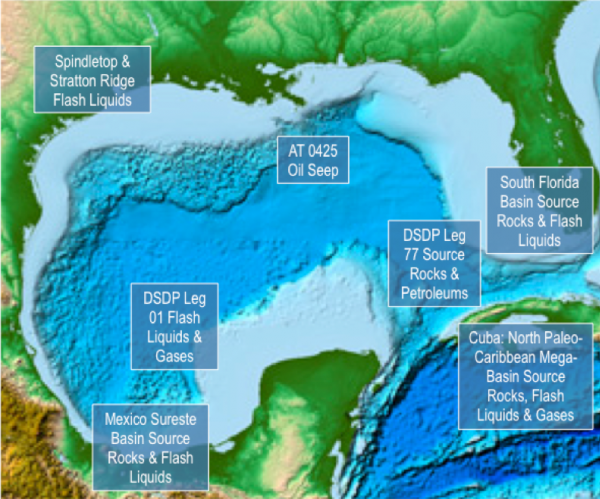Petroleum System Study (PSS) series
These topical reports contain a fresh look at, and modern re-interpretation of, publically available data. It’s amazing what can sometimes be seen in old data under a modern lens and / or within a modern regional framework! t!Ps™ uses its latest (completed or proto-type) Tools in the evaluation, as appropriate. There are two types of Study: Topical Petroleum System Studies chosen for relevance to basins / plays of the day. If you’re tired of reading third party reports based on little real information, then t!Ps™ TPS Studies are assured to include a material and relevant volume of public data, assimilated and (re-)interpreted to advance your understanding (.pdf format, with accompanying DRB available in .xlsx format) First study available January 2016: Petroleum Systems of the Deep Water Gulf of Mexico Basin and North Caribbean Margin – Insights from the Deep Sea Drilling Program Classic Petroleum System Studies chosen for their value as Petroleum System analogs. Many basins and plays have been studied piecemeal and / or at some considerable time in the past using a now-outdated geological or conceptual framework; or totally lacking Petroleum Systems thinking. t!Ps™ CPS Studies take a modern first-principles look at how the System works. Examples are chosen to illustrate the fluid system in particular; and are typical of an Organofacies
- Charge: starting with the source rock, understand depositional controls on Organofacies and Source Potential. Understand thermics, thermal stress, pressure and maturity that govern Charge Access via expulsion and migration from source bed to trap
- Reservoir: aquifer-reservoir distribution impacts secondary migration during Charge Access. Understand reservoir fluid properties that impact Storage and Deliverability; and how effective stress and thermal stress govern the reservoir rock properties of porosity, impacting Storage, and permeability, impacting Deliverability.
- Trap: learn what kinds of container Geometry actually work; and Column Capacity – to what extent is the size of the trap limited by supportable column height? In other words, follow migration from source to trap!
Exploring the Mexican / US Gulf of Mexico or the North Caribbean?
 Petroleum Systems of the Deep Water Gulf of Mexico and North Caribbean Margin – Insights from the Deep Sea Drilling Program | January 2016
Petroleum Systems of the Deep Water Gulf of Mexico and North Caribbean Margin – Insights from the Deep Sea Drilling Program | January 2016
This Study [PSS01] and companion Basin-Processed Data volume [BPD01] extract diverse information and an all-new interpretation from key DSDP wells in the deep water GoM basin. Included are pertinent data interpretations from Mexico, South Florida and Cuba, placing the deep water well results in the context of the nearest working Petroleum Systems. The recognition of multiple source rocks and Petroleum Systems, and expulsion at very shallow depth, have wide implications for exploration of Mesozoic-sourced Petroleum Systems in the Caribbean as well as the Mexican and US GoM.
Risk Elements addressed:
Source Potential – in the present day central deep water US / Mexico basin there is risk associated with the ‘donut hole’, caused by seafloor spreading, in the distribution of the basin’s main Upper Jurassic source rocks
Charge Access – the nature and origin of petroleum occurrences in the DSDP wells, interpreted in context with the nearest Petroleum Systems in South Florida, Cuba and Mexico. Analysis includes thermal and expulsion history in the Florida Straits
LEARN MORE ABOUT PSS01 & BPD01
LEARN MORE ABOUT T!PS™ PETROLEUM SYSTEMS STUDIES – info@ThisIsPetroleumSystems.com

